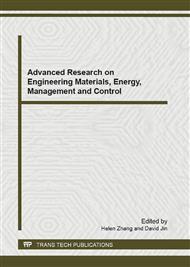[1]
Finkel, P., Godinez, V., Miller, R., Finlayson, R.: Electromagnetically Induced Acoustic Emission-Novel NDT Technique for Damage Evaluation. In: AIP Conference Proceedings, pp.1747-1754. American Institute of Physics (2001).
DOI: 10.1063/1.1373964
Google Scholar
[2]
Liang, Jin, Qingxin, Yang, Suzhen, Liu, Chuang, Zhang, Peng, Li: Electromagnetic Stimulation of the Acoustic Emission for Fatigue Crack Detection of the Sheet Metal. J. IEEE Transactions on Applied Superconductivity. 20, 1848-1851 (2010).
DOI: 10.1109/tasc.2010.2042795
Google Scholar
[3]
Thomas, Jin, Chee, Liu: Finite Element Modeling of Melting Crack Tip under Thermo-Electric Joule Heating. J. Engineering Fracture Mechanics. 78, 666-684 (2011).
DOI: 10.1016/j.engfracmech.2010.12.007
Google Scholar
[4]
Teramoto, T., Nagai, T., Utsugi, Y., Saito, M.: Numerical Analysis on Fracture Behavior of a Single-Edge-Cracked Plate Subjected to Electromagnetic Force. J. Fusion Engineering and Design. 42, 389-394 (1998).
DOI: 10.1016/s0920-3796(98)00344-5
Google Scholar
[5]
Gary, X., Cai, Yuan, F., G.: Electric Current-Induced Stresses at the Crack Tip in Conductors. J. International Journal of Fracture. 96, 279-301(1999).
Google Scholar
[6]
Golosnoy, I. O., Sykulski, J., K.: Numerical Modeling of Non-Linear Coupled Thermo-Electric Problems: A Comparative Study. J. The International Journal for Computation and Mathematics in Electrical and Electronic Engineering. 28, 639-655(2009).
DOI: 10.1108/03321640910940909
Google Scholar
[7]
Ungera, J., Stiemerb, M., Schwarzec, M., Svendsena, B., Blumb, H., Reesec, S.: Strategies for 3D Simulation of Electromagnetic Forming Processes. J. Journal of Materials Processing Technology. 199, 341–362(2008).
Google Scholar
[8]
ANSYS, Inc., ANSYS 10. 0 HTML Online Documentation. SAS IP, Inc., USA (2005).
Google Scholar
[9]
Jiangbo, Wang, Junhua, Wang, Chunsheng, Li: Study of Induction Eddy Current Distribution Based on FEM. J. International Conference on Electrical Machines and Systems. 1, 421-423(2008).
Google Scholar


